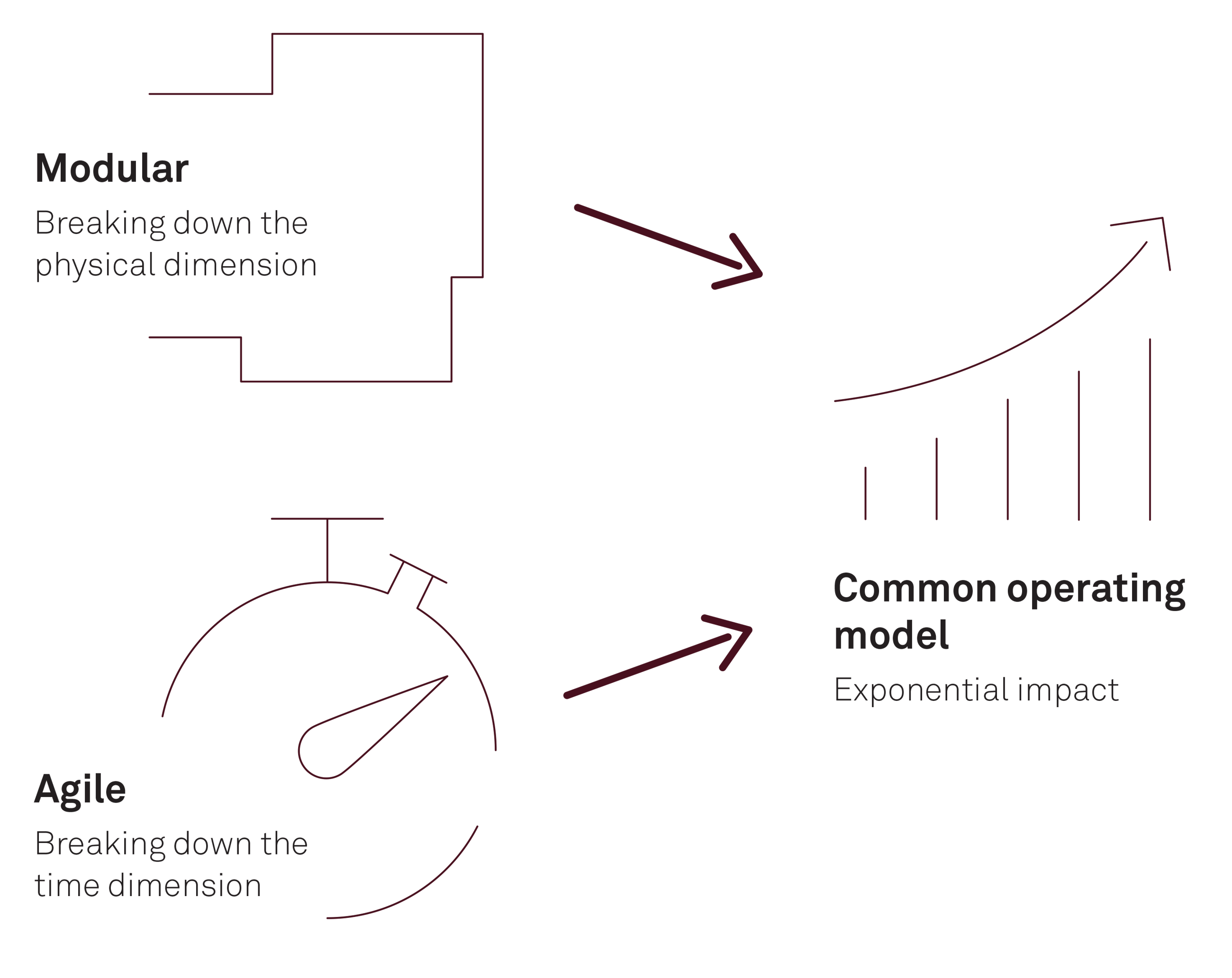Article
– Integrate Modular AND Agile
Published
4 December 2023
Imagine a future where customers are addicted to your products because they always contain the latest technology and valuecreating features. A future where teams work independently and efficiently on solution subsets with full market impact accountability. A future that welcomes many more developers to engage in design activities with a business owner’s mindset.
The integration of modular product architecture and agile development can bring companies much closer to such future dreams.
This article explores why this approach holds unrealised impact potential for most businesses and provides practical tips on how to implement it successfully.
We dive into the significance of end-to-end accountability, aligning modules with customer “jobs-to-be-done” and leveraging robust interfaces, independent cross-functional (module) teams and integration testing as part of the agile cadence – from day 1.
The advantages of integrating Modular AND Agile
There are several quite persuasive business arguments for combining product modularity with agile execution:
- Higher customer satisfaction: Simpler products and user experiences that are easier to comprehend, along with the possibility for customers to independently upgrade or customise specific parts of the product.
- Shorter time between new market releases: By breaking down products into smaller modules, businesses can accelerate product development and release modules independently in shorter cycles. Renewing and improving a product on a weekly or monthly basis rather than introducing a new model every three or four years is what keeps customers addicted to your brand.
- Enhanced product performance: Modularisation promotes superior design and testing practices because issues can be isolated and improved separately without affecting the entire system. This results in high-quality products with minimal defects.
- Increased adaptability: Agile and modularisation enable businesses to adapt swiftly and efficiently to evolving issues or customer needs by adjusting or introducing new features to existing modules rather than redesigning the complete product.
- Increased development efficiency and speed: Distinct modules and clear interfaces allow development teams to develop and release independently and with a minimum of coordination and complexity waste. This is always a good idea but particularly so if solution teams work at a different clock speeds.
- Reduced development and supply chain costs: Due to a higher degree of reusability, increasing economies of scale and a focused team effort, development and supply chain costs are lowered.
How to integrate Modular AND Agile?
For most innovators and developers, the Modular AND Agile benefits are not hard to understand. But how to go about it, and how to make improvements from the current maturity level?
In many instances, modularity and product architecture are viewed as a static engineering discipline separate from the dynamic discipline of agile development and releases. In addition, it is often people with different mindsets who sit in either camp. It is almost obvious that aligning delivery architecture with solution architecture will create synergies and reduce handover and disengagement waste.
The modules of the product define the structure of the company, and any company team that is not a module of a product slows the company down.
J. Justice.
Breaking development projects (i.e. solutions) into smaller units facilitates rapid development while the architectural overview makes it possible for everyone to understand how each component and each module contribute value to the entire product or portfolio.
But there is more …
Excessively complex modular frameworks can impede development rather than aid it. So, be aware of not building a new engineering bureaucracy or a slow decision hierarchy. Instead, focus on essential product features, extreme reuse of modules, scalability (considering scenarios of rapid growth), minimising dependencies and delegated decision power.
It is often an advantage to revolve a modular approach around customer needs and functionality rather than technical component types or material types. This ensures that teams remain end-to-end focused on delivering exceptional customer experiences and that they do not get lost in the technical weeds or inside-out thinking.
Clearly defined interface rules are essential for efficient communication between modules. Interface management enables effective integration and mitigates the risk of delays or unpleasant surprises further down the value chain.
Development teams should comprise members with diverse skill sets, including product owners, developers, commercial specialists and supply chain experts. A cross-functional commitment towards end-to-end customer targets serves as a strong driver of, well, customer impact.
The team and project setup should mirror the solution architecture with distinct boundaries between modules and a continuous focus on integration testing throughout the development cycle. For smaller products, it may not be feasible with module teams, but for larger products, make sure to limit sub- (module) teams to 5-6 cross-functional people.
Integration testing should be an ongoing process from the beginning, starting with defining test pass criteria and test design. Testing should cover technical and commercial assumptions with the same level of rigour and should happen in a “real-world” situation. This early testing allows for fast validation of design and business impact.
Recurrent demo session and integration events – part of the agile sprint cadence – provide a valuable platform for identifying issues related to module and total system performance. Demo sessions should not just show (module) solutions but also how solutions perform in usage scenarios. This iterative approach helps teams refine and enhance the product during the development phase based on real evidence rather than the internal opinion of leaders.
We hope you agree. It is not about implementing either product modularity or agile development to gain larger benefits – it is about integrating the two.
The difficulty of successfully integrating Modular AND Agile
Despite the widespread recognition among leaders of benefits and needed integration efforts, its successful implementation remains challenging for many organisations.
One reason is the lack of buy-in from all stakeholders in the organisation, ranging from executive leadership to individual team members. Without a shared understanding of the benefits and a commitment to embrace these principles, consistent implementation becomes difficult.
The complexity of modern products and systems poses another challenge. As products become increasingly interconnected and the number of modules and interfaces grows, maintaining a clear understanding of the overall system architecture and ensuring proper integration and testing becomes
more difficult.
Organisational and cultural barriers also impede success. Siloed or hierarchical organisational structures hinder product thinking, cross-functional teams and fluid collaboration. If functional leaders are overly focused on their own targets and budgets without a business owner’s mindset, change will be hard. Additionally, teams and individuals may find it challenging to change routines and habits.
The job here is to truly understand what makes it challenging and address the underlying problems.
Possible next steps to initiate – or repeat
No matter where you are on your Modular AND Agile journey, there is always a next step that is right for you. Below, we outline some steps you could consider discussing with your leadership team.
A. Develop a shared and profound understanding of the potential benefits. To ensure the success of this approach, it is crucial to secure buy-in from key stakeholders, creating awareness around the specific benefits of modularity and agile execution. Consider maturity assessments, analyses, cases, training and workshops. In addition, teams should be encouraged to share their experiences and learnings, strengthening the culture and mindset of continuous improvement. Make reuse and simplicity “cool”.
B. Implement a modular architecture framework or simplify the existing one. Mirror it with your organisational architecture. To ensure proper integration and testing, companies can establish a modular architecture framework that defines the rules and principles of module design and development. This framework should encompass guidelines for interface creation and continuous renewal, module boundaries and non-negotiable interface rules. By creating a common language and understanding of module integration, this framework minimises the risk of integration problems.
C. Focus on customer journeys. Promote a culture of collaboration and align cross-functional teams towards shared customer objectives. Encourage teams to collaborate throughout the customer journey, assigning clear responsibilities and end-to-end accountability for customer impact.
D. Think about your potential improvement journey in a Modular AND Agile way. Break down the change challenge – like any other modular solution. What is the first small solution that will deliver end-to-end value – in a limited area?
E. Finally, be curious. Look at what is already out there. The world is big. Someone similar to you has “nailed it” somewhere. Look at all kinds of companies. But software companies may be more advanced when it comes to combining modules, i.e. object-oriented design, with agile/sprintbased releases. Look at physical product companies that operate like software companies. Look at Tesla.
Case in point – Tesla
Many myths surround Tesla. A lot of them come from the colourful nature of its founder and his clan of followers. But it is indisputable that Tesla has revolutionised a very large and conservative industry. First, of course, by seeing the market opportunities of EVs and charging networks but also by rethinking the architecture and development of products and related processes.
They apply an extreme degree of reuse, where engineers in legacy companies are often biased towards new and exciting design activities. They apply true DevOps (i.e. design, R&D and manufacturing) teams sitting on the manufacturing floor within 10 meters of their module. Manufacturing is not a lower-grade job compared to design or R&D. They release module changes directly to the production line without a lengthy approval process in the engineering hierarchy.
They have completely changed the serial manufacturing chain that others spend decades optimising. They independently design, develop and manufacture large modules and “snap” them together in the final assembly. This parallel, “unboxed” process has delivered impressive results: 44% improved operator density and a 40% reduction in footprint.
They make all customer and car data available to all module teams in real time to continuously improve modules. At Tesla, data is your boss and more important than the opinions of the highest-paid employees. These Modular AND Agile principles have helped create a unit profit that is five times what legacy automotive companies achieve for EVs.
Tesla definitely seems to lead the pack and to be in a very strong competitive situation. But even if you do not work for Tesla and do not feel much like Elon Musk, you can use their Modular AND Agile principles and proof to challenge the ways of working in your organisation.
We are Agile and Modular nerds0 4
0
4Reach out if you have questions, contrarian views or any kind of reflections. We love to discuss how business impact and happiness can be accelerated.
Related0 4
Case
Read more
Global pharmaceutical company
How do you get rid of waste in the healthcare value chain through circular solutions?Article
Read more
Strategic innovation
“Innovation” per se resonates positive for most business leaders, and few would argue that it is unnecessary or a waste ...Article
Read more
Steering logistics services towards zero emissions
New procurement playbook with best practices, concrete guidelines and concepts for procuring sustainable logistics servi...Case
Read more





